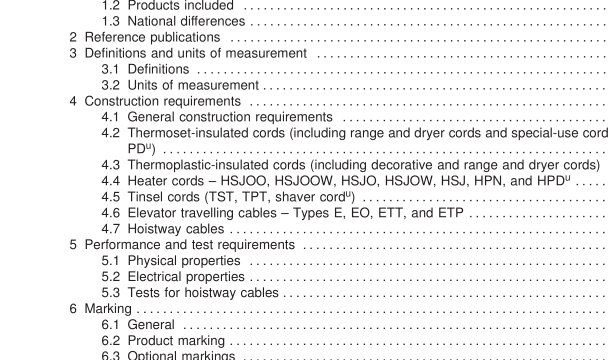UL 62-2010 pdf download.Flexible Cords and Cables.
Hard-usage cord – a cord intended for use with moderately heavy equipment and for hand-held appliances and tools, classified as the medium grade in mechanical serviceability. Heater cord – a cord intended for connection to equipment that has a heating element. Hoistway cable – a cable for control and signal applications in an elevator hoistway. Neutral conductor – a conductor of a polyphase circuit or single phase, 3-wire circuit that is intended to have voltage such that the voltage difference between it and each of the other conductors is approximately equal in magnitude and is equally spaced in phase. Normal vision – vision without any aid other than the examiner’s normal corrective lenses, if any. Not-for-hard-usage cord – a cord intended for use with light equipment, classified as the lowest grade in mechanical serviceability. Room temperature – 25 ±1 0°C (77 ±1 8°F). Rope-lay-stranded conductor – a conductor composed of groups of twisted strands having one or more layers. Thermoplastic – a polymeric-based material that can be repeatedly softened by heating and hardened by cooling, and that in the softened state can be shaped through the application of force. Thermoplastic elastomer (TPE) – a thermoplastic that complies with the deformation test in Clause 5.1 .3 for compound classes 1 4, 1 5, 1 6, 1 .9, 1 .1 0, 1 .1 1 and the heat-shock resistance test in Clause 5.1 .8 for TPE materials. Thermoset – a cross-linked polymeric-based material that will not soften to the point of flowing with subsequent application of heat. Tinsel cord – cords intended for use only in lengths that do not exceed 2.4 m (8 ft) and that are attached either directly or by means of a special type of attachment plug to a portable electric appliance rated at 0.5 A or less. Ungrounded Conductor – circuit conductor that is not connected to ground.
4 Construction requirements 4.1 General construction requirements 4.1 .1 Conductors 4.1 .1 .1 General The conductors of all types of cables and cords shall use flexible stranding, except as detailed under specific constructions. Circuit conductors of mixed sizes shall be permitted for cords containing five or more circuit conductors. 4.1 .1 .2 Material Conductors shall be of annealed copper in compliance with ASTM B 3 or NMX-J-036-ANCE, or annealed coated copper in compliance with ASTM B 33 or NMX-J-008-ANCE. 4.1 .1 .3 Size 4.1 .1 .3.1 The conductor size shall be determined by both items (a) and (b): (a) The cross-sectional area (stranded conductor) or the diameter (solid conductor) shall not exceed the maximum values given in Table 1 . The cross-sectional area shall be determined in accordance with the method specified in the test, Cross-sectional area, by diameter method described in CAN/CSA-C22.2 No. 2556, UL 2556, or Annex C of NMX-J-066-ANCE. The diameter shall be determined in accordance with the method specified in the test, Conductor Diameter, described in CAN/CSA-C22.2 No. 2556, UL 2556, or NMX-J- 066-ANCE. (b) The dc resistance of uncoated copper or tin-coated copper conductors shall be as specified in Tables 4, 5, 6, and 7. A plus tolerance of 2% shall be permitted in the case of a conductor in a twisted multiconductor product having a single layer of conductors. For a twisted multiconductor having more than one layer, a plus tolerance of 3% shall be permitted. Compliance shall be determined in accordance with the test, DC Resistance, in CAN/CSA- C22.2 No. 2556, UL 2556, or NMX-J-21 2-ANCE.
4.1 .1 .4 Joints 4.1 .1 .4.1 A joint or splice in one of the individual wires of a stranded conductor shall neither increase the diameter nor decrease the strength of the conductor or the individual wire. A joint or splice shall not be made in a stranded conductor as a whole. For rope-lay-stranded conductor construction, the splicing of a stranded member (primary group) as a unit shall be permitted provided that no joints are made closer than two lay lengths apart. 4.1 .1 .4.2 A joint or splice in a solid conductor shall neither increase the diameter nor decrease the strength of the conductor. 4.1 .1 .5 Coating If the conductor and insulation have been shown to be mutually compatible in accordance with Clause 5.2.8, omission of the coating shall be permitted. Otherwise, if a separator is not provided over the conductor, all the individual wires of the conductor shall be separately tinned. 4.1 .1 .6 Separator 4.1 .1 .6.1 When the conductor is neither coated nor shown to be mutually compatible with the insulation in accordance with Clause 5.2.8, a separator as described in Clause 4.1 .1 .6.3 shall be provided over the conductor. 4.1 .1 .6.2 A separator shall be permitted on other constructions, but is not required. 4.1 .1 .6.3 A separator, when provided, is not required to cover the conductor completely unless it is required in order to comply with the copper corrosion test specified in Clause 5.2.8. It shall be of a colour contrasting to that of the conductor, except clear or green or green/yellow shall not be permitted. The separator shall consist of (a) close spiralling of fine fibrous yarn, paper, cellophane, or polyester tape; (b) braid of fine fibrous yarn; or (c) longitudinally applied wrap of paper, cellophane, or polyester.UL 62-2010 pdf download.
UL 62-2010 pdf download
